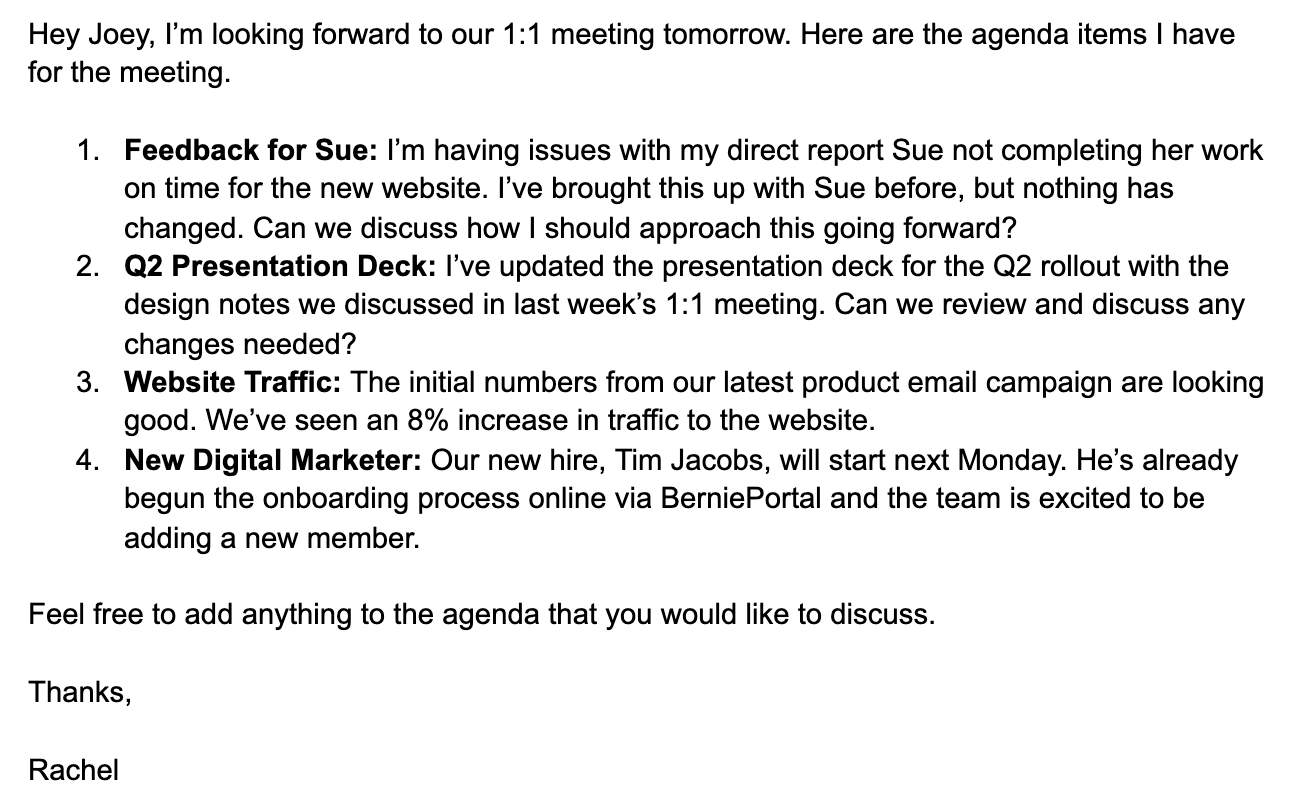
Written by
Drew Gieseke
Drew Gieseke is an aPHR®-certified marketing professional who writes about HR, compliance, and healthcare solutions.
Retention Strategies: Are 1:1s the New Stay & Exit Interviews?

Stay and exit interviews are a tool of the past. When conducted as part of a larger employee retention strategy, HR can improve the company culture and the day-to-day operations of an organization by employing ongoing 1:1 meetings instead. Find out why stay and exit interviews no longer get the job done—and how you can implement 1:1 meetings to replace them.
What is an Exit Interview?
An exit interview is a conversation traditionally conducted between an employer and an employee just before the worker leaves the organization. In these discussions, the two talk about the worker’s reasons for leaving and their overall experience while at the organization.
Traditionally, exit interviews served as important opportunities for employers to improve company culture and make adjustments or improvements to the departing employee’s role. However, in many cases, this feedback is too little, too late.
What is a Stay Interview?
Meanwhile, a stay interview is a conversation traditionally conducted with current employees where HR asks questions regarding why they continue working for the organization.
Questions that might be asked during a stay interview include:
- What kind of feedback or recognition would you like about your performance that you aren’t currently receiving?
- What opportunities for self-improvement would you like to have that go beyond your current role?
- What kind of flexibility would be most helpful to you in balancing your work and home life?
- What talents, interests or skills do you have that we haven’t made the most of?
- If you could change one thing about your job, what would it be?
Why Should Employers Stop Using Stay and Exit Interviews?
Traditionally, stay and exit interviews take the place of more frequent, ongoing feedback. Management teams who rely on these methods miss out on coaching opportunities throughout the year.
Not to mention that in many cases, issues discussed in stay and exit interviews are often identified far too late:
- In exit interviews, an employee has already decided to leave the organization!
- Meanwhile, stay interviews may do more harm than good by implicitly communicating to employees that changes need to be made (and that it’s incumbent on the employee to identify these adjustments).
How to Replace Stay and Exit Interviews with 1:1 Meetings
Weekly one-to-one meetings—otherwise stylized as 1:1 meetings—between managers and team members can serve as an integral part of a company’s culture and performance management strategy. Teams that prioritize 1:1 meetings between managers and their employees establish a consistent and reliable channel for mission-critical information to get to the right places (both upward and downward on the organizational chart).
In other words, the 1:1 should be the primary mechanism for organizations to use to ensure high-quality feedback and improvement.
Why 1:1 Meetings Are So Important for Employee Retention
Employee retention is an ongoing process. As a result, it’s better for managers to engage in continuous conversations with their employees each week or every other week to cover projects and tasks that need to be addressed.
1:1 meetings also provide the following insights:
- Warning signs that indicate employees need more support and direction
- Points of pain in an employee’s output and productivity
- Opportunities for employees to develop new skills and abilities
- Insights for managers to improve their own practices
Sample 1:1 Meeting Template
In a Culture Guide or employee handbook, HR should include the following 1:1 template to set an example for both managers and employees:
How We Conduct 1:1s
Effective 1:1s are critical to the growth of our company and its teammates. Here is how it works:
- What they Are: Weekly meetings with your manager or the person to whom you report.
- Who Makes the Agenda: You do. Included items should be areas where you could use extra help/support/advice or feedback. Additionally, you should include items that may have come up during the week that are better discussed in person and updates on projects for which you’re responsible.
- When to Send the Agenda: Use the performance management function in the HRIS to post your agenda for your manager’s review and reference. This should arrive no later than 24 hours before the 1:1. You should treat this priority with as much urgency as getting back to an important client.
- Additions to the Agenda: Your manager may have additional items to add to the agenda; in the performance management thread, they’ll post these discussion points as a reply to your initial agenda.
- Summary: Use the performance management function in the HRIS to reply to that week’s thread with a summary of key takeaways from the meeting. This should be posted no later than the next day (and ideally the same day).
With these principles in mind, here's an example of a great 1:1 meeting agenda:

How to Replace Stay and Exit Interviews with 1:1 Meetings
To implement 1:1 meetings, HR should follow these steps:
- Determine Length and Frequency of the Meeting: The frequency and length of 1:1 meetings will depend on your organization. Most range from 30-90 minutes and occur weekly, but managers of larger teams might consider every two weeks or monthly meetings.
- Schedule Recurring Meetings: Scheduling the meetings ahead of time on the same day every week will help maintain consistency and routine. It’s easier for an employee to prepare for the 1:1 meeting when they know when to expect it every week.
- Document the Meetings: It’s important to gather all correspondence and remain compliant by allowing managers to see communication and feel confident employees are receiving coaching.
- Set Documentation Expectations: Agendas before the meeting and recaps after the meeting both help document what an employee and manager want to discuss, as well as provides documentation of what was discussed. Require employees to send 1:1 agendas at least 24 hours before the 1:1 to allow managers time to respond with additional notes or agenda items to add. Within 24 hours following a 1:1 meeting, the employee should send a detailed summary of discussions. Managers should respond to the summary clarifying any points requiring summarization from the manager.

Written by
Drew Gieseke
Drew Gieseke is an aPHR®-certified marketing professional who writes about HR, compliance, and healthcare solutions.
Related Posts
Yes, you can use a health savings account, or HSA, for cosmetic surgery, but only in...
According to the KPMG 2023 CEO Outlook, 64% of business leaders believe there will be a...
Thomas J. Peters, best known for his book In Search of Excellence, once stated, “The day...
According to the Ethics and Compliance Initiative’s (ECI) 2023 Global Business Ethics...







Submit a Comment